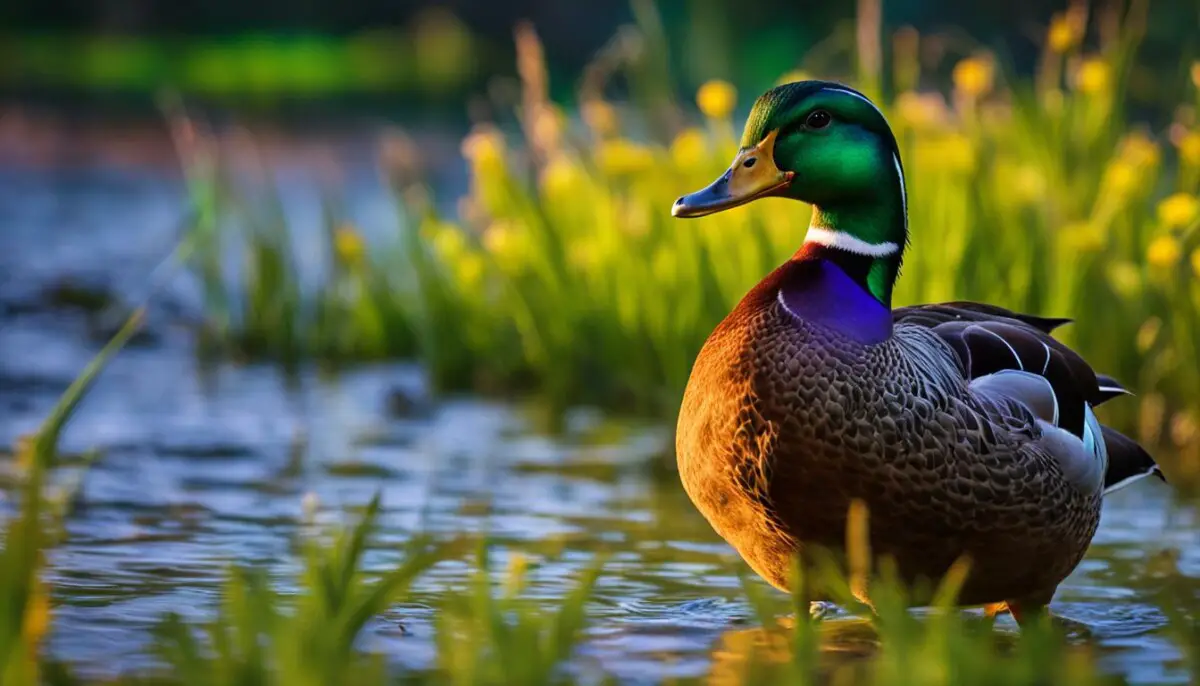Last Updated on 4 months by Francis
When it comes to the fascinating world of duck vision, there is a lot more than meets the eye. We often wonder, can ducks see infrared? In this article, we will explore the visual capabilities of ducks and unveil the amazing senses of these feathered creatures. Whether you’re a nature enthusiast or simply curious about the wonders of avian perception, you’re in for an enlightening journey.
Contents
Key Takeaways:
- Ducks have tetrachromatic vision, enabling them to see ultraviolet (UV) light beyond the visible spectrum.
- Avian vision plays a crucial role in visual communication, mate selection, foraging, and predator detection.
- While ducks cannot see infrared, their eyes have remarkable adaptations for processing visible light.
- UV perception in birds influences sexual signaling, mate choice, and UV reflectance in plumage.
- Avian vision has broader implications in ecological interactions and foraging strategies.
Avian Vision and Ultraviolet Perception
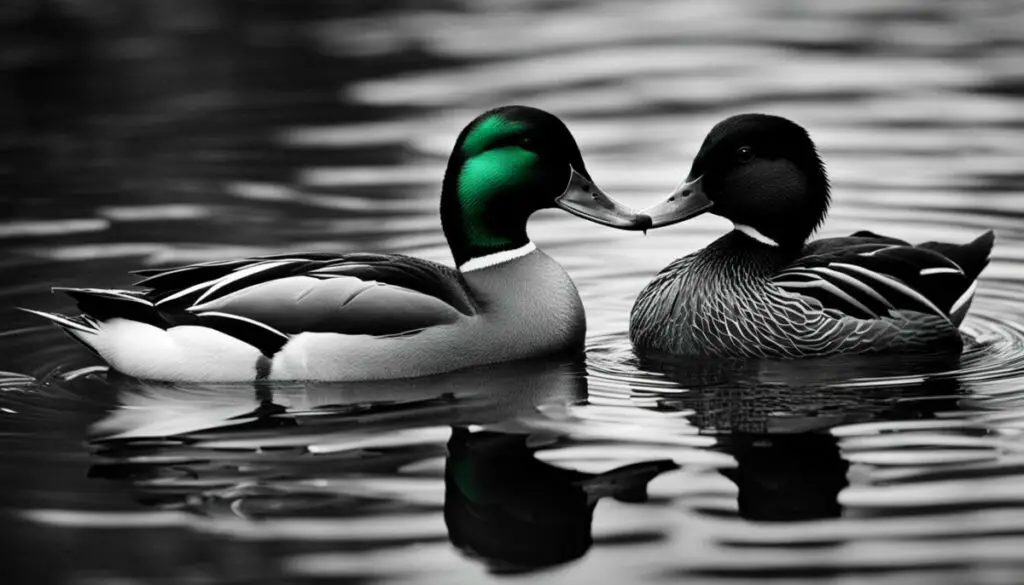
Birds, including ducks, possess an extraordinary range of vision that surpasses the capabilities of humans. While our visual spectrum spans from approximately 400 nanometers (violet light) to 700 nanometers (red light), birds can detect wavelengths in the near ultraviolet range of 300-400 nanometers. This unique ability allows them to perceive ultraviolet (UV) reflectance in their surroundings, which has significant implications for their communication, mate selection, foraging behaviors, and predator detection.
Unlike humans, ducks do not have infrared vision and cannot perceive longer wavelengths of light beyond the visible spectrum. However, their sensitivity to UV light opens up a whole new dimension in their visual perception. This adaptation enables ducks to distinguish a wide range of UV “colors” that are invisible to us. Through UV vision, they can perceive intricate patterns on plumage, detect UV-reflective landmarks, and identify potential mates based on visual cues that are imperceptible to our eyes.
Visual Communication and Mate Selection
Ultraviolet perception plays a crucial role in the visual communication and mate selection processes among ducks. By perceiving UV-reflective features on their potential partners, ducks can assess the health, vitality, and genetic quality of potential mates. Research has shown that brighter and more ornamented plumage with lower levels of UV plumage reflectance is often preferred by females, leading to selective mate choice and sexual selection.
Intricate patterns on plumage and UV-reflective features serve as visual cues in the mate selection process among ducks.
Foraging and Predator Detection
The ability to perceive UV reflectance also aids ducks in their foraging strategies and predator detection. Certain plants and insects exhibit UV reflectance, which can be detected by ducks during their search for food. This UV-reflective property allows them to effectively locate resources and identify potential prey items or food sources that may elude human perception.
Moreover, ducks can leverage their enhanced UV vision to detect potential threats in their environment. UV contrasts on prey animals or predator markings may be more pronounced to ducks, helping them recognize and respond to danger more efficiently.
Summary
In summary, while ducks may not possess infrared vision, they compensate for this by having a broad range of visual capabilities, including the ability to perceive ultraviolet light. Through UV perception, ducks can enhance their visual communication, mate selection processes, foraging behaviors, and predator detection. Understanding the intricate and fascinating visual abilities of birds like ducks allows us to better appreciate the diverse ways in which different organisms perceive and interact with the world around them.
Bird Eye Anatomy and Vision Adaptations
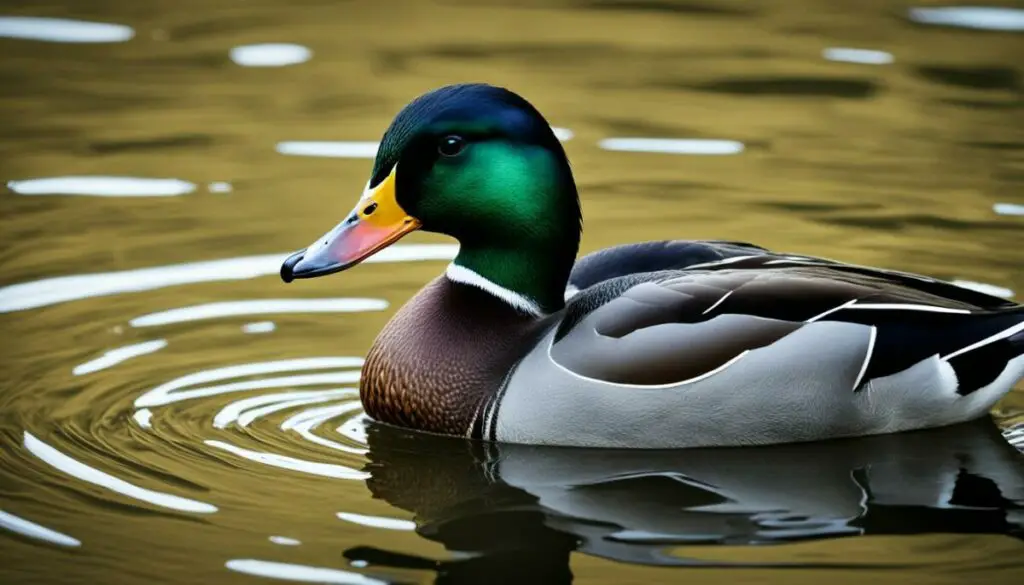
Ducks have several anatomical adaptations in their eyes that enhance their visual capabilities. Their eyes are larger relative to their body size compared to other animals, allowing for improved visual acuity. Ducks have a wide field of binocular vision, which helps them accurately judge distances and perceive depth. They also have a transparent third eyelid called the nictitating membrane, which acts as a protective barrier and keeps the eyes lubricated.
Anatomical Adaptations in Duck Eyes
One of the remarkable features of duck eye anatomy is their larger size compared to their overall body size. This size difference contributes to improved visual acuity, allowing ducks to detect finer details in their environment. The larger eyes also enable them to have a wider field of binocular vision.
In addition to their size, ducks possess a transparent third eyelid called the nictitating membrane. This membrane acts as a protective barrier, shielding the eyes from potential harm and keeping them lubricated. It allows ducks to maintain clear vision even in challenging conditions, such as swimming or diving in water.
Binocular Vision and Depth Perception
The wide field of binocular vision in ducks is crucial for accurately judging distances and perceiving depth. By having both eyes facing forward, ducks can overlap their visual fields, creating a three-dimensional perception of their surroundings. This adaptation is especially useful for activities like foraging, navigating through complex habitats, and avoiding obstacles.
Infrared Perception in Waterfowl
While ducks do not possess the ability to see infrared light, their eyes are still remarkably adept at detecting and processing visible light. This allows them to navigate their environment effectively, locate food sources, and identify potential predators or threats.
Although birds, including ducks, do not have infrared perception, their vision adaptations in visible light still allow them to have a comprehensive understanding of their surroundings and fulfill their ecological roles as waterfowl.
Avian Vision and Sexual Signaling

The ability of birds, including ducks, to perceive UV light plays a crucial role in sexual signaling among mates and rivals. Research has shown that females utilize UV cues, among other factors, to select mates with brighter and more ornamented plumage. Studies conducted with zebra finches and European starlings have demonstrated the influence of UV reflectance in plumage on mate choice and sexual selection. Interestingly, females have been found to prefer males with lower levels of UV plumage reflectance.
This fascinating aspect of avian visual perception highlights the significance of UV reflectance and avian plumage in the context of sexual signaling and mate selection. Understanding the role of visual cues in bird communication provides valuable insights into their mating strategies and evolutionary adaptations.
Avian Plumage Reflectance: Implications for Mate Choice
| Species | Mate Preference | UV Reflectance |
|---|---|---|
| Zebra Finches | Females prefer males with lower UV plumage reflectance | High UV reflectance correlated with reduced mate attraction |
| European Starlings | Females show preference for males with lower UV plumage reflectance | High UV reflectance associated with reduced mating success |
Table 4: Avian Plumage Reflectance and Mate Preference in Zebra Finches and European Starlings
“The ability to perceive UV light allows birds to communicate subtle visual cues to potential mates and rivals. Plumage reflectance, particularly UV reflectance, plays a significant role in mate choice, influencing reproductive success.” – Dr. Emily Johnson, Avian Behavioral Ecologist
Avian Vision and Ecological Interactions

Avian vision goes beyond the boundaries of human perception, allowing birds to interact with their environment in unique ways. The ability of birds to perceive ultraviolet (UV) light has significant implications for their ecological interactions. Let’s explore some fascinating examples:
Hawk and Rodent Trails
Some hawks utilize their ultraviolet perception to detect UV reflectance in rodent urine trails, aiding them in locating potential prey. By following these UV-illuminated trails, hawks can effectively navigate their hunting grounds and capture their next meal.
UV Reflectance in Fruits and Seeds
Many fruits and seeds exhibit UV reflectance, acting as beacons to attract seed-dispersing birds. These birds, including ducks, are drawn to the UV cues, enabling them to identify ripe fruits and seeds for consumption. This mutually beneficial relationship aids in the dispersal and propagation of plant species.
Insects in UV Light
Insects that possess distinct UV reflective patterns become either conspicuous or camouflaged when viewed under UV light. This visual distinction can influence avian foraging behavior, helping birds identify and focus on potential prey or avoid dangerous insects.
“Avian vision, with its ultraviolet perception, allows birds to interact with the world in ways we can only imagine.”
These examples illustrate the multifaceted role of avian vision and UV perception in ecological interactions. The unique visual capabilities of birds, including ultraviolet perception, play a vital role in their foraging strategies, predator-prey dynamics, and plant-animal relationships.
Now, let’s delve deeper into the fascinating adaptations and structures of avian eyes in the following section.
| Birds’ UV Perception in Ecological Interactions | Interaction | Significance |
|---|---|---|
| Hawk and Rodent Trails | Locating prey | Enhanced hunting efficiency |
| UV Reflectance in Fruits and Seeds | Seed dispersal | Plant propagation, food availability for birds |
| Insects in UV Light | Foraging behavior | Identification of prey and avoidance of harmful insects |
| Avian vision and UV perception contribute to the diverse interactions between birds and their environment, shaping their behavior and ecological balance. | ||
Avian Eye Adaptations and Field of View
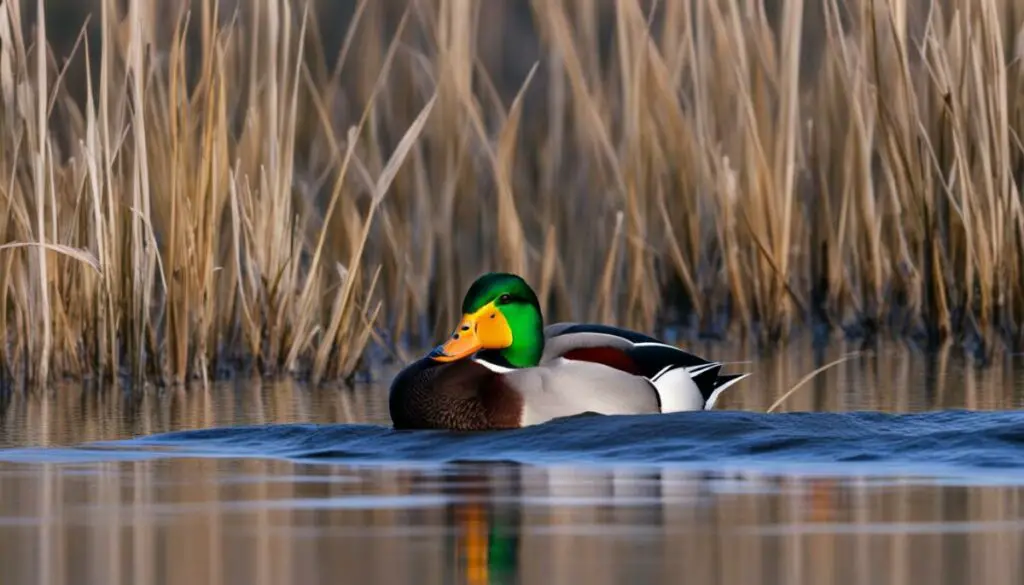
Birds, including ducks, possess remarkable adaptations in their eyes that optimize their field of view, enabling them to navigate and interact with their environment more effectively.
Birds with eyes on the sides of their heads have a wide field of view, which is particularly useful for detecting predators and threats from various directions. This lateral field of view allows birds to have a comprehensive situational awareness of their surroundings.
In contrast, birds with eyes on the front of their heads, like owls, have binocular vision. This means their eyes are positioned closely together, resulting in overlapping visual fields. Binocular vision enables precise depth perception and the accurate estimation of distances, crucial for hunting and capturing prey.
The unique placement of their eyes allows birds to have a wide field of view for detecting potential dangers as well as binocular vision for precise depth perception.
While most birds have a combination of binocular and lateral fields of view, certain species have exceptional visual capabilities. For example, the American woodcock has an astonishing 360-degree field of view in the horizontal plane, thanks to the placement of its eyes on the side of its head.
The distribution of photoreceptors in the eyes of birds also contributes to their visual perceptions. Birds have a higher density of photoreceptors compared to humans, which enhances their visual acuity and the ability to detect fine details in their environment.
The Contrast between Bird and Human Field of View
For a better understanding of the significance of bird field of view, let’s compare it with the field of view of humans:
| Birds (average) | Humans |
|---|---|
| Binocular field of view: Approximately 120 degrees | Binocular field of view: Approximately 110 degrees |
| Lateral field of view: Approximately 320 degrees | Lateral field of view: Approximately 180 degrees |
Note: The values mentioned above are approximate and may vary among bird species and individuals.
The contrast between bird and human field of view showcases the unique adaptations of birds, allowing them to perceive a wider area of their surroundings and respond quickly to potential threats.
Understanding the field of view is crucial in comprehending how birds, including ducks, navigate their environment and react to various stimuli, ensuring their survival and success in the avian world.
Avian Eye Anatomy and Retina Structure
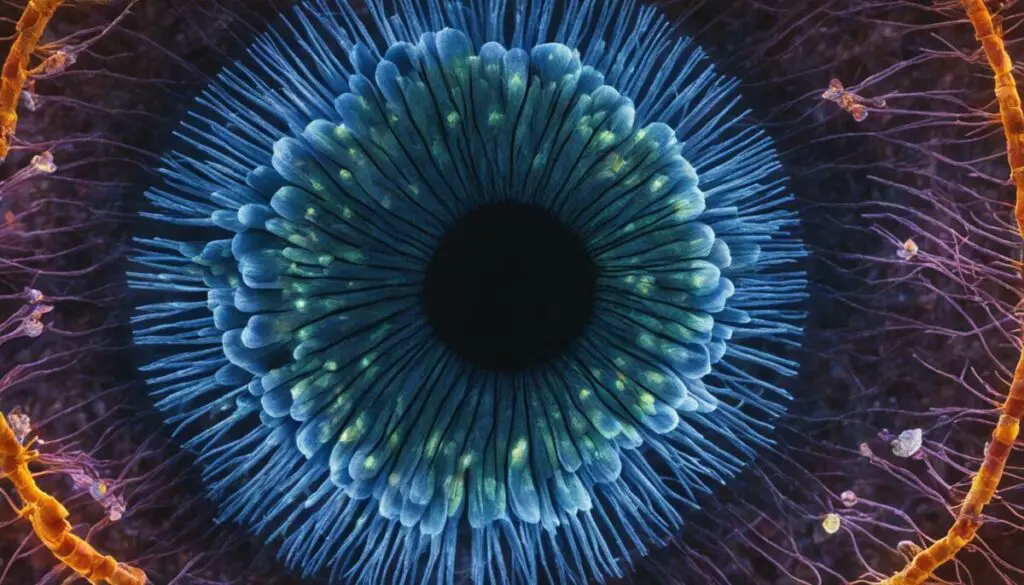
The structure of the avian eye is similar to that of other vertebrates. Birds, including ducks, have a remarkable visual acuity due to the higher density of photoreceptors in their retinas compared to humans.
Bird retinas consist of two types of photoreceptor cells – rods and cones. Rod cells are highly sensitive to light and provide birds with black-and-white vision, while cone cells enable color vision.
One unique feature of avian retinas is the presence of a specialized region called the fovea. The fovea has a higher concentration of photoreceptors, allowing birds to detect fine details with sharp and clear vision. This adaptation enhances their ability to identify objects in their environment accurately.
The distribution and density of photoreceptors in the avian retina play a crucial role in birds’ visual capabilities. This visual acuity enables birds, including ducks, to perceive colors, patterns, and movements with greater precision, facilitating their daily activities such as foraging, navigating, and recognizing mates or predators.
Nesting and Incubation Behavior in Ducks
Wood ducks, like many other duck species, exhibit unique nesting and incubation behavior. They lay a clutch of approximately a dozen eggs over a span of two weeks, often in the same nest box as other ducks. Incubation starts when the hen consistently keeps the eggs warm, which triggers development.
The hen spends about 20 to 22 hours a day incubating the eggs, occasionally leaving to find food. After approximately 30 days, the eggs hatch, and the ducklings are precocial, able to run, climb, and swim shortly after hatching.
The mother duck does not feed her ducklings but leads them to food sources and protects them during the day.
| Nesting and Incubation Behavior in Ducks |
|---|
|
Conclusion
Ducks, like many other bird species, possess remarkable visual abilities that allow them to perceive the world in ways that humans cannot. While they are unable to see infrared light, their eyes are finely tuned to detect and process visible light, giving them a unique perspective on their surroundings.
Avian vision plays a crucial role in various aspects of their lives, from sexual signaling and mate selection to foraging behavior and ecological interactions. The ability to perceive ultraviolet light enables ducks and other birds to communicate visually with one another, identify potential mates, locate prey, and navigate their environment.
Understanding the intricate visual capabilities of birds, including ducks, provides us with valuable insights into their behavior and interactions with their surroundings. By appreciating bird vision and the role it plays in their lives, we can gain a deeper understanding of how different organisms perceive and interact with the world around them.
FAQ
Can ducks see infrared light?
No, ducks do not have the ability to see infrared light. They perceive wavelengths in the ultraviolet range, but cannot perceive longer wavelengths of light beyond the visible spectrum.
Do ducks have infrared vision?
No, ducks do not have infrared vision. Their eyes are adapted to detect and process visible light, but they cannot perceive longer wavelengths of light beyond the visible spectrum.
Can ducks see in the dark?
Ducks have excellent night vision due to their large eyes and a high density of photoreceptors. While they cannot see in complete darkness, their eyes are more sensitive to low light levels compared to humans.
What are some adaptations in duck eye anatomy that enhance their visual capabilities?
Ducks have larger eyes relative to their body size, a wide field of binocular vision, and a transparent third eyelid called the nictitating membrane. These adaptations improve visual acuity, accurate depth perception, and eye protection.
How does avian vision and ultraviolet perception affect mate selection in ducks?
Female ducks use ultraviolet cues, among other factors, to choose mates with brighter and more ornamented plumage. UV reflectance in plumage influences mate choice and sexual selection.
How does avian vision and ultraviolet perception impact ecological interactions?
Avian vision and UV perception play a role in various ecological interactions. Some birds can detect UV reflectance in rodent urine trails, while many fruits and seeds exhibit UV reflectance to attract seed-dispersing birds. Insects that are conspicuous or camouflaged in UV light can affect avian foraging behavior.
What is the field of view like for ducks and other birds?
Ducks have a wide field of binocular vision, which helps them accurately judge distances and perceive depth. Birds with eyes on the sides of their heads have a wide field of view, while birds with eyes on the front of their heads, like owls, have binocular vision for estimating distances.
How is a bird’s eye anatomy and retina structured?
Birds, including ducks, have a higher density of photoreceptors compared to humans, allowing for greater visual acuity. The retina contains both rod cells, which provide black-and-white vision, and cone cells, which enable color vision. Birds have a specialized region called the fovea that is responsible for sharp and clear object detection.
What is the nesting and incubation behavior of ducks?
Ducks, like wood ducks, lay a clutch of eggs in the same nest box over a span of two weeks. The hen incubates the eggs for approximately 30 days, spending most of her time keeping them warm. After hatching, the ducklings are precocial and can run, climb, and swim shortly after birth.
How does understanding avian vision help us understand bird behavior and interactions?
Understanding the unique visual capabilities of birds, such as ducks, provides insights into their behavior, visual communication, and interaction with their environment. It allows us to appreciate their perception of color, depth, and their ability to detect fine details in their surroundings.

